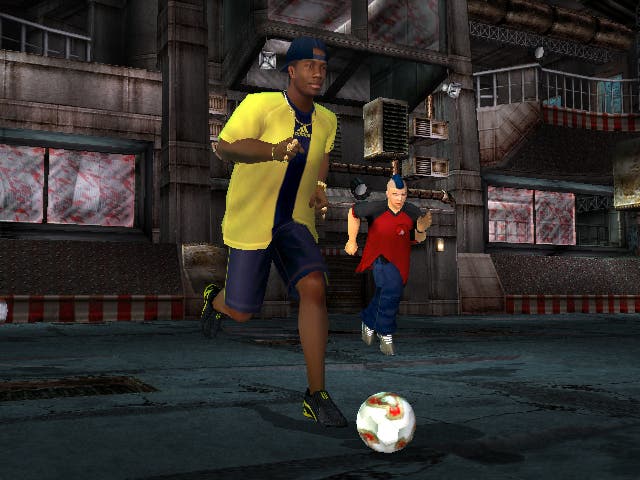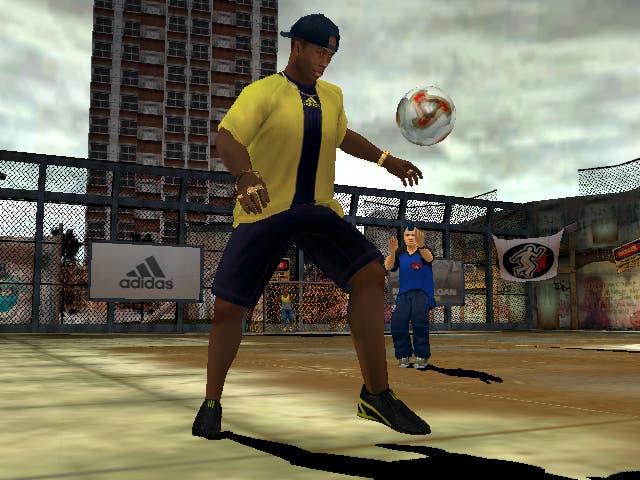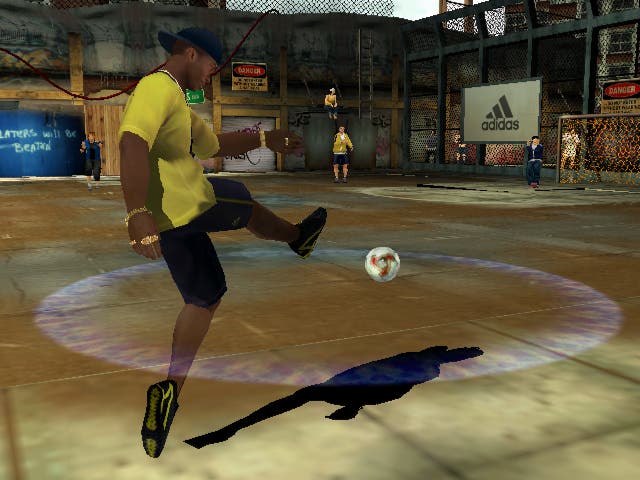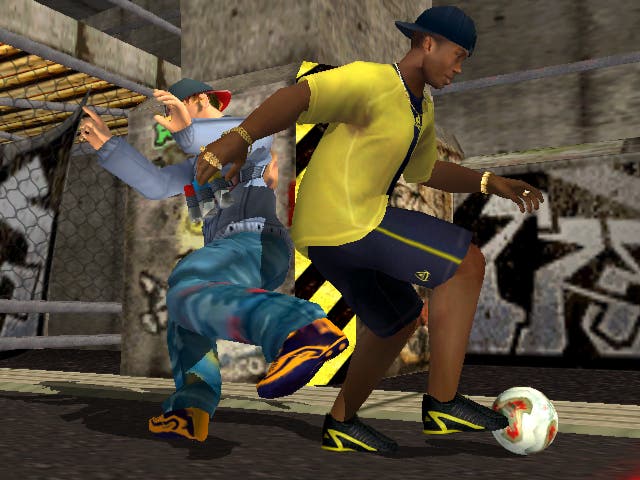Urban Freestyle Soccer
Back of the net, or bottom of the league?
Urban. Freestyle. Soccer. They're just not trying any more, are they? That said; it does at least clarify rather succinctly what we're dealing with. Here's the more elaborate, rent-paying version: Imagine, if you will, a game of four-a-side football played by six Cristiano Ronaldos outfield, and a pair of Rene Higuitas [the chap who did the "scorpion kick" at Wembley in the 90s -Ed] between the sticks at either end. Then imagine the ball responding in increasingly unconvincing and physics-defying ways to the ridiculous speed, precision and trickery of each cherubic protagonist, throw a bucket of mud over the whole lot and sing "What a load of bollocks!" from your imaginary dug-out.
A Little Less Imagination

Urban Freestyle Soccer, as the name suggests, takes football out of the luxuriously realised, glossy, multi-million-pound sports arenas and plunges it into various "urban" locations, like a square in Chinatown with ornate archways for goalposts, a rundown schoolyard, or industrial districts with scaffolding and loading bays at either end, and each small, enclosed pitch blessed with its own individual quirks like skateboarding spectators and team banners rippling and flapping in the breeze. And instead of commentary, here we have the ranks of skater kids, street punks and quite frankly skanky ho's shouting along to the action like a Mikey Streets tribute act. The game is soccer (or FOOTBALL as we like to call it) and the currency is creativity - not yours mind, as all you'll be doing is reeling off trick after trick by holding L1 and stabbing a face button.
Player movement is fast and fluid and the controls are highly responsive, perhaps even disorientating at first, and apart from the showboating you can also pass with X, shoot with square, "kick" with triangle, chip with circle, and sprint with R1 if your blue sprint/special meter is sufficiently juiced. Player selection is cyclic for some reason, so it can be a pain picking the right player in a crunch situation, but then again there's no offside to worry about, you won't be penalised for any vicious fouls you commit (or attempt to commit) - there isn't even a referee - and there are no substitutions or injuries either, as your players are all sufficiently hard that nothing knocks them out for longer than a frame or two.
On the whole it's very easy to pick up thanks to the simple and responsive play mechanics, and a fairly thorough if unevenly paced training mode walks you through all the various tricks, from the obvious flicks, roly-poly tricks and cartwheels to throwing pitch-side objects like plastic chairs and tyres, and of course, the five-a-side favourite, passing to yourself using the wall. Passing and shooting couldn't be simpler - every pass is a bullet to feet and every chip a mortar round worthy of Roach from Apocalypse Now, in this instance with your striker's generally uncontested header goalward playing the role of the screaming Charlie. Goals are frequent.
A Little More Action

On the other hand, goals in UFS are immediately hamstrung by both setting and standing. Real goals prompt an emotional eruption in a lot of fans, which is muted somewhat when you're seeing 20 goals in a match, and also critically when you lose the fantastic sight of a bulging net. Any football fan will find the lack of a traditional goal in most of the pitches here disappointing, especially when the ball bounces off a back wall and rather disrespectfully back onto the pitch as the players start to celebrate. After initial excitement, goals don't seem as special or significant in UFS.
Netbusters, in particular, are something of a letdown. Soccer Slam gave us a selection of individually tailored strikes that matched a particular player - ridiculously extravagant and unrealistic shots that you still had a job scoring despite a gravity-defying height advantage. They were useful, tricky, and rewarding to score. UFS gives us a handful of different "uber" sort of shots that are almost guaranteed to go in and send out a shockwave that knocks surrounding players to the ground. By charging up your netbuster meter with tricks you're given a window of 20 seconds to get the ball into a static searchlight and, with L1 and R1 held down, hit a face button to initiate one of the showpiece shots. To be honest, I found them rather anticlimactic, and soon repetitive, and in such a high scoring game they had little bearing - they were just a safe point both teams could bank either side of half time.
As with the original NBA Street, to use an example UFS certainly learnt from, defending is a lot harder on the whole than attacking. Ironically, a degree of sometimes-acute slowdown can work to your advantage when you're trying to slide-tackle somebody, but after a while possession is almost as good as a goal. Chipped passes loop through the air from virtually anywhere on the pitch into a prime heading or volleying position. You can even chip a cross with a back-heel. In fact there are plenty of obvious approaches that are difficult to defend against, and you'll find some games are decided by how often the lousy collision detection or some AI quirk inadvertently broke down one of your attacks.
All This Aggravation

Now to be fair to UFS, it does a lot of things right. You can see what's going on most of the time thanks to a choice of decent side-on camera positions, it's smooth and responsive to control, it's full of the sort of silky skills that make football look elegant and occasionally miraculous, and for a while it grows more and more engaging as you become more accomplished.
Its principle fault however is that it's too eager to please. Although you can unlock more teams and a couple of new game modes, the basic play-set is there from the first kickabout, and you'll quickly discover that the extravagant flicks, turns and shots can be as boring and brainless in saturation as watching the current Liverpool team playing for a draw. Tricks are common currency and easy to perform, and thanks to some odd animation clashes, occasionally shifty AI and quirks that leave the game confused as to whether the ball's in play or not, it's a pretty dispassionate experience for the lone player. Throw in up to three friends and it gathers a bit of momentum, but on the whole the consensus seems to be that if a footy game wants to latch onto the instinctive male adulation of obscure and mystifying ball tricks and spectacular goals, then it either needs to be totally over the top and mechanically sound (like Soccer Slam), or utterly realistic. UFS is loitering somewhere in-between.
In a game about intricate skills their presentation is of paramount importance, and UFS doesn't really get this right. It probably looks a bit better on the GameCube and much better on the Xbox, but our PS2 review copy is really jagged and slowdown is rife - particularly when solid objects in the foreground obscure the camera and the game renders the players behind in bizarre Predator-o-vision. There's a lot of pitch-side detail, it has to be said, but it feels like it's trying too hard. Mish-mashing of animations and character models can really take the shine off an otherwise spectacular piece of play, and the automatic replays accentuate this more than anything - UFS could have done with more focus on the principles and less on the mood.
No Satisfaction In Me

Try as you might though, you can't escape the "Urban" trappings. Each 'hood' team has its own theme song, pitch and regional dialect, mostly English (or borderline). The central game mode is called Turf Wars, and involves invading various neighbouring 'hoods to conquer the crummy little strip of land the players call home. Introductory sequences give you an idea of the 'hood's "style", each victory gives you a bunch of upgrade points to spend improving your team's vital statistics, and the choice of backing track depends on your opponents. And, unfortunately, on you. The music tries to help out, it really does, but suffers from this crippling flaw - despite encompassing wide spread of styles, as tracks from TLC brush shoulders with the Foo Fighters, you wind up listening to your own team's song for one half of every game. Even going four minutes per half, it won't take many Turf Wars to tire of the same song.
The song issue is just another little niggle in a game that has rather too many little niggles already. Sadly for Urban Freestyle Soccer, it's a pretty forgettable football-without-football exercise in showboating for the sake of it. It's not horrendous by any means, and not all that objectionable to play, but it's yet another example of a distinctly average "extreme sports" game that lacks the polish and creativity of the real-life sportsmen it's trying to emulate-slash-harness. You'd be better off watching that five-a-side-on-a-boat-with-Elvis-and-Cantona advert again. That was everything this isn't. Next!

